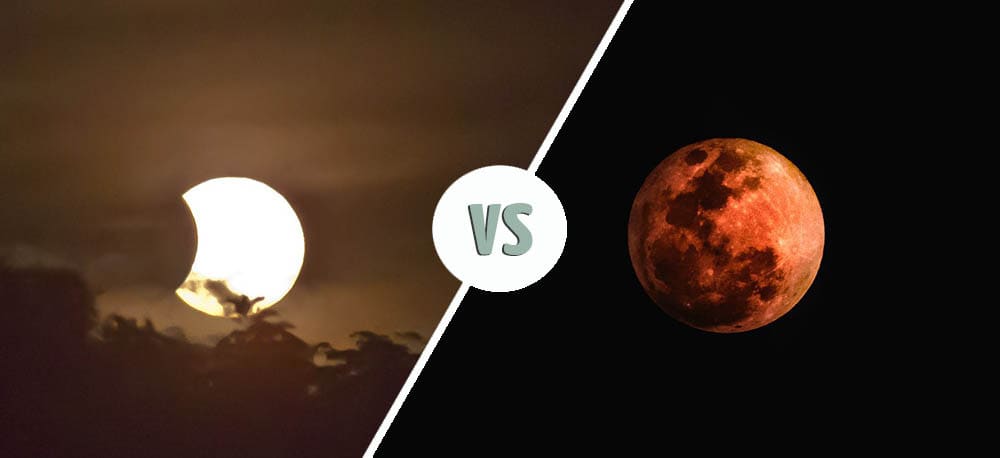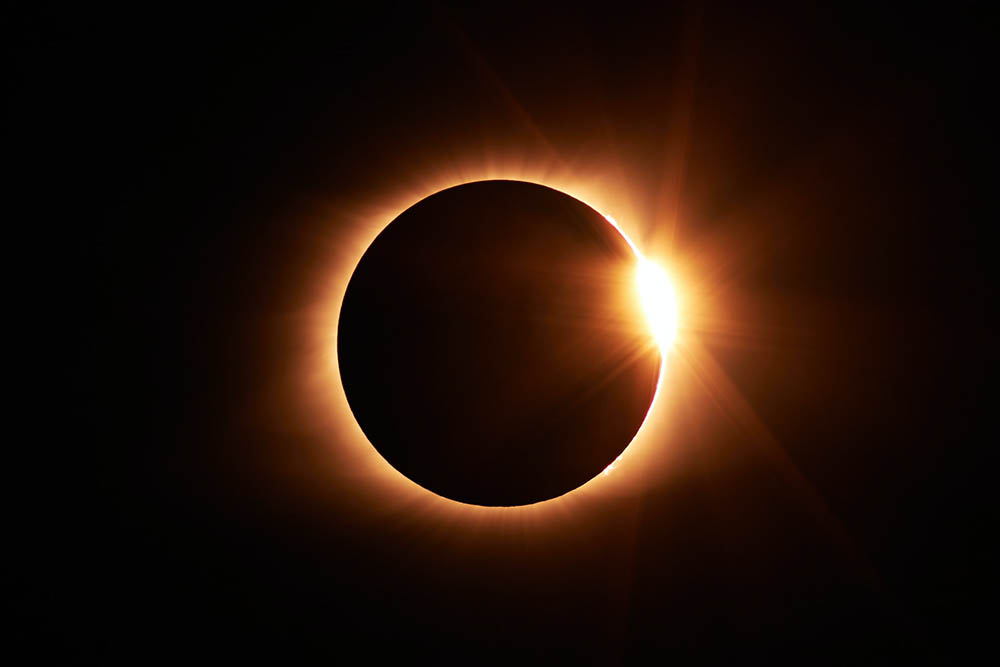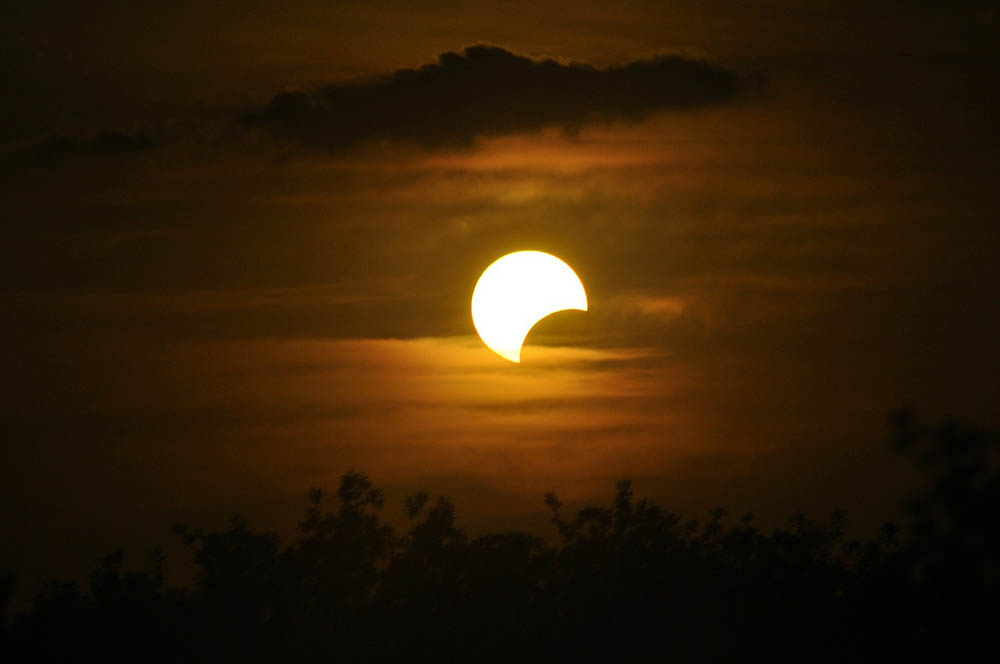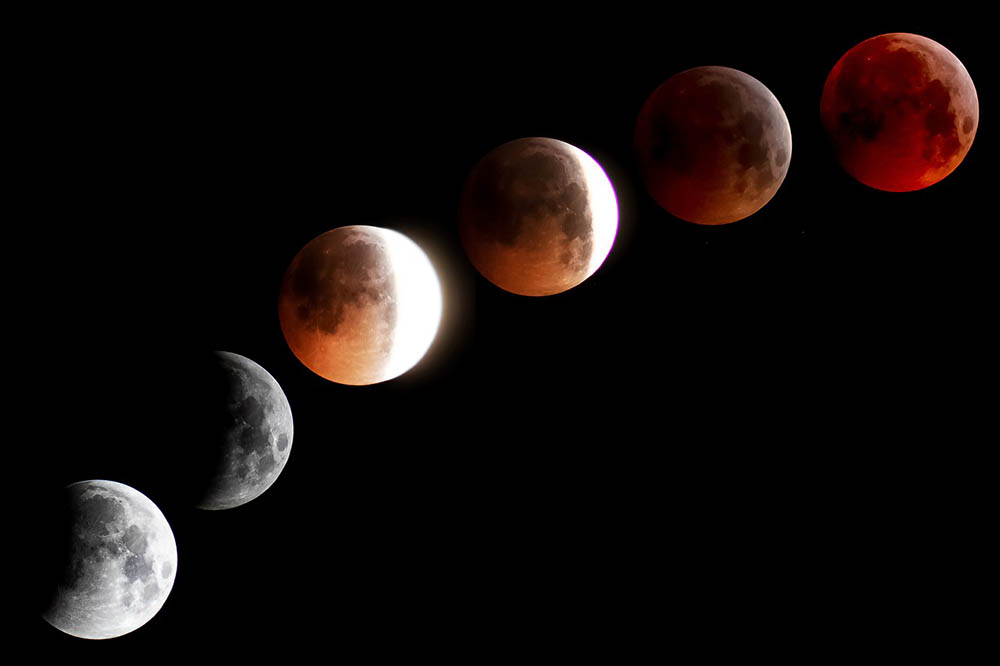Solar vs. Lunar Eclipse: What’s the Difference?
Last Updated on

Eclipses have fascinated people all over the world for millennia and have been deeply studied by astronomers for centuries. In ancient times, eclipses were often seen as bad omens and were thought to foreshadow the coming of tough times.
However, with our knowledge of celestial mechanics, we now know that eclipses are simply a celestial coincidence boiling down to the relative size, distance, and orientation between the Sun, Earth, and Moon. Seeing a solar or lunar eclipse is a unique opportunity and definitely not worth missing.
If you’re interested in learning more about solar and lunar eclipses, here’s everything you need to know about the basics. Keep reading to get excited about the next eclipse season!

Overview of a Solar Eclipse
Solar eclipses are some of the most incredible natural phenomena and only occur during the phase of the new Moon. A variety of criteria and mathematical precision have to be fulfilled in order for a solar eclipse to take place, with certain types of solar eclipses being rarer than others.
A solar eclipse occurs when the Sun, Moon, and Earth are perfectly aligned, which only happens when the Moon is closest to the ecliptic plane, or the plane of Earth’s orbit around the Sun. This type of alignment is called syzygy, which is astronomical terminology for a roughly straight-line configuration of three or more celestial bodies in a gravitational system.
Once these criteria are fulfilled, a solar eclipse will occur when a portion of the Earth becomes enveloped in a shadow cast by the Moon as it fully or partially blocks the Sun’s light. There are only two and occasionally three periods in which a solar eclipse can occur, known as the “eclipse season.”
During this time, the moon is at a low ecliptic latitude, which is generally about 1.5 degrees north or south. Each eclipse season lasts for 31-37 days, with the next season occurring approximately six months later. During every eclipse season, at least two solar or lunar eclipses will occur, with some seasons accommodating up to three.

Types of Solar Eclipses
There are several types of solar eclipses, with each one occurring depending on the orientation between the Earth, Sun, and Moon. The rarest type is called a total solar eclipse, which is by far the most spectacular to watch. However, even partial and annular solar eclipses are worth watching and shouldn’t be missed.
Total Solar Eclipse
Total solar eclipses are among the rarest to occur and only happen when the Moon almost completely blocks the Sun’s light. If the Moon were closer to Earth and maintained a perfectly circular orbit, a total solar eclipse would occur once every new Moon. However, the Moon’s orbit is tilted by approximately 5 degrees relative to the Earth’s orbit around the Sun. Many may consider this to be a negligible difference. Still, this discrepancy means that the Moon’s shadow will usually miss Earth, which is part of the reason total solar eclipses are so rare.
When a total solar eclipse occurs, it can only be observed from a small area on Earth. In order to see a total eclipse, you must be in line with the center of the shadow that the Moon casts on the Earth. As the Moon passes in front of the sun, the sky becomes dark as night as the eclipse reaches totality. In general, totality lasts for about 2 minutes, but depending on the conditions, it can last for up to seven minutes and 32 seconds. On average, a total solar eclipse occurs somewhere on Earth every 18 months.
Partial Solar Eclipse
A partial solar eclipse occurs when the Sun, Moon, and Earth are not completely aligned. As a result, this type of eclipse is characterized by a dark shadow on only part of the Sun’s surface. As a total eclipse requires extreme mathematical precision, partial eclipses are usually the most common type to be observed.
Annular Solar Eclipse
Annular solar eclipses are somewhat uncommon and occur when the Moon is farthest from the Earth. Because the Moon is further away and looks smaller from Earth, it will not completely block the Sun’s light. Instead, annular eclipses are characterized by a dark, disc-shaped shadow on the Sun. In addition, the Sun’s light will form a halo or ring around the Moon’s silhouette, which is sometimes referred to as “the ring of fire.” The Latin word “annularis” means “ring” and is the origin of this eclipse’s namesake.

How to See a Solar Eclipse
Having the opportunity to see a solar eclipse is an incredible and unique experience. However, looking directly at a solar eclipse can also be very dangerous. The only time it is safe to look at a solar eclipse with the naked eye is during totality, as much of the Sun’s dangerous light is blocked out.
Protect Your Eyes
When viewing an eclipse, it is tremendously important to protect your eyes against infrared radiation by using a solar filter, as it can cause permanent damage. Just as a magnifying glass can tightly focus the Sun’s rays so they burn something, so can your eyes. When sunlight enters your eye’s lens, it gets concentrated and focused onto a very small spot on your retina. Because there are no pain sensors in your eyes, it can be very easy to burn them, which can even cause blindness without you knowing.

What to Expect
During a total solar eclipse, the Sun takes on the form of a black disc surrounded by a light, wispy border. This memorable phenomenon is due to the Sun’s outer atmosphere, or corona. It is also common to see subtle, pink bumps around the edge of the disc, which are called prominences. Prominences occur when part of the Sun’s surface becomes unstable, causing it to burst outwards and release a glowing plasma.
You can also expect to see bands of shadows racing along the ground as the Sun is entering or emerging from a total eclipse. Additionally, it is likely that you’ll be able to make out some of the brightest stars and planets, including Venus and Jupiter, as you observe the eclipse.
Solar eclipses are a totally unique event that not only makes us wonder, but wildlife as well. Because a solar eclipse can make even the brightest day look convincingly like night, birds may stop singing, and other animals may make their way towards their dens. However, after the eclipse has passed, it looks as if nothing ever happened, which adds to the confusion.

Overview of a Lunar Eclipse
Unlike a solar eclipse, a lunar eclipse occurs on the night of the full Moon when the Moon moves into the Earth’s shadow. This only occurs when the Earth is perfectly aligned between the Sun and the Moon in syzygy. Lunar eclipses can be viewed anywhere from the night side of Earth and can last for up to 2 hours, which is significantly longer than a solar eclipse.
What makes a lunar eclipse, or “blood moon,” unique is the reddish color of the totally eclipsed moon. Because the Earth blocks the Sun’s light from the Moon, it is instead refracted by Earth’s atmosphere, giving the moon a red hue. On average, a total lunar eclipse can be observed from any point on Earth every two and a half years.

Types of Lunar Eclipses
Although lunar eclipses are more common than solar eclipses, they can still present themselves in a variety of different ways. Depending on the celestial conditions present, a lunar eclipse may be total, partial, or penumbral, with each type occurring at different frequencies.
Total Lunar Eclipse
During a total lunar eclipse, the Earth’s full shadow, or umbra, is cast on the moon. A total lunar eclipse can be easy to miss if you are not looking for it, as the Moon becomes cast in a sinister shadow that can be hard to differentiate from the night sky. If you were to stand on the surface of the Moon during a total lunar eclipse and look back at Earth, you would see the Earth as a black disc surrounded by a ring of reflected sunlight.
Partial Lunar Eclipse
A partial lunar eclipse occurs when only a portion of the Moon enters Earth’s umbra. During this type of lunar eclipse, the Sun, Earth, and Moon are not perfectly aligned, which makes it seem as if Earth’s shadow took a “bite” out of the moon. Each partial lunar eclipse is somewhat different, with the celestial conditions governing how the Earth’s shadow is cast on the Moon.

Penumbral Lunar Eclipse
Although a penumbral lunar eclipse sounds cool, it is perhaps the least interesting of the eclipses. This type of eclipse occurs when the Moon passes through Earth’s penumbra, or the lightest part of its shadow. It is likely that you won’t even notice a penumbral lunar eclipse, as they are only faintly visible with the naked eye when about 70% of the Moon’s diameter has entered the penumbra. Even during a rare total penumbral eclipse, the only observable effect is a slight dimming of the Moon’s surface.

Differences Between Solar and Lunar Eclipses
Although solar and lunar eclipses are fundamentally the same, they have very different properties that distinguish them from each other. Both solar and lunar eclipses occur once a variety of celestial mechanics parameters are met and are truly astronomical coincidences.
If the size or distance between the Sun, Earth, and Moon were to change, it is very likely that we wouldn’t be able to observe eclipses at all. However, because we have been able to observe solar and lunar eclipses, we have been able to learn more about our place in the universe. To better understand the properties of solar and lunar eclipses, take a look at the basics of how they differ from one another.
- A solar eclipse happens about once every 18 months.
- A solar eclipse can only be seen from a small portion of the Earth during the day.
- Solar eclipses occur during the new Moon.
- Solar eclipses are unsafe to watch with the naked eye.
- Solar eclipses occur when the Moon passes between the Earth and the Sun.
- A solar eclipse lasts for only a few minutes.
- A lunar eclipse occurs twice per year.
- A lunar eclipse can be seen from anywhere on the night-side of the Earth.
- Lunar eclipses occur during the full Moon.
- Lunar eclipses are perfectly safe to watch without eye protection.
- Lunar eclipses occur when the Earth passes between the Moon and Sun.
- A lunar eclipse can last for up to two hours.

Conclusion
Throughout history, both solar and lunar eclipses have inspired awe and fear in those fortunate enough to observe them. Eclipses were subject to some bad publicity in ancient times when they were thought to be associated with bad omens. Now that we understand the scientific principles behind solar and lunar eclipses, we can use them to our advantage and understand our small nook in the universe in a deeper way.
Watching a solar or lunar eclipse, especially during totality, is a memorable experience that you’ll surely never forget. It is by pure celestial coincidence that we even get to observe them in the first place, so if you have the opportunity to see one, you definitely won’t regret it.
Featured Image Credit: (L) sandid, Pixabay | (R) ktphotography, Pixabay
About the Author Robert Sparks
Robert’s obsession with all things optical started early in life, when his optician father would bring home prototypes for Robert to play with. Nowadays, Robert is dedicated to helping others find the right optics for their needs. His hobbies include astronomy, astrophysics, and model building. Originally from Newark, NJ, he resides in Santa Fe, New Mexico, where the nighttime skies are filled with glittering stars.
Related Articles:
How to Clean a Refractor Telescope: Step-by-Step Guide
How to Clean a Telescope Eyepiece: Step-by-Step Guide
How to Clean a Rifle Scope: 8 Expert Tips
Monocular vs Telescope: Differences Explained (With Pictures)
What Is a Monocular Used For? 8 Common Functions
How to Clean a Telescope Mirror: 8 Expert Tips
Brightfield vs Phase Contrast Microscopy: The Differences Explained
SkyCamHD Drone Review: Pros, Cons, FAQ, & Verdict
